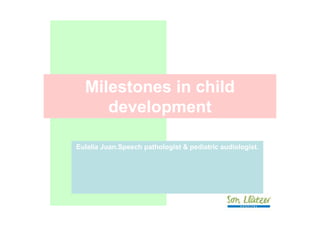Milestones in child development
•Als PPT, PDF herunterladen•
4 gefällt mir•1,538 views
Melden
Teilen
Melden
Teilen

Empfohlen
Integrating Listening and Spoken Language into Daily Routine - Christine Evan...

Integrating Listening and Spoken Language into Daily Routine - Christine Evan...Monika Lehnhardt PhD
Empfohlen
Integrating Listening and Spoken Language into Daily Routine - Christine Evan...

Integrating Listening and Spoken Language into Daily Routine - Christine Evan...Monika Lehnhardt PhD
Актуальные тенденции в сфере слуховых устройств (Actual Trends in Hearing Ins...

Актуальные тенденции в сфере слуховых устройств (Actual Trends in Hearing Ins...Monika Lehnhardt PhD
Основные этапы развития языковых навыков у детей - Main stages in pediatric l...

Основные этапы развития языковых навыков у детей - Main stages in pediatric l...Monika Lehnhardt PhD
Rehabilitation through remote fitting in the Muenster hearing implant center ...

Rehabilitation through remote fitting in the Muenster hearing implant center ...Monika Lehnhardt PhD
Weitere ähnliche Inhalte
Andere mochten auch
Актуальные тенденции в сфере слуховых устройств (Actual Trends in Hearing Ins...

Актуальные тенденции в сфере слуховых устройств (Actual Trends in Hearing Ins...Monika Lehnhardt PhD
Основные этапы развития языковых навыков у детей - Main stages in pediatric l...

Основные этапы развития языковых навыков у детей - Main stages in pediatric l...Monika Lehnhardt PhD
Rehabilitation through remote fitting in the Muenster hearing implant center ...

Rehabilitation through remote fitting in the Muenster hearing implant center ...Monika Lehnhardt PhD
Andere mochten auch (20)
Работа с родителями слабослышащих и глухих детей - Йоанна Космалова, RU

Работа с родителями слабослышащих и глухих детей - Йоанна Космалова, RU
Viktorija Mcdonell - Listen learn and talk - complete presentation ENG+RU

Viktorija Mcdonell - Listen learn and talk - complete presentation ENG+RU
Время сменить парадигму клинического обслуживания - Моника Ленхардт, РУ

Время сменить парадигму клинического обслуживания - Моника Ленхардт, РУ
Актуальные тенденции в сфере слуховых устройств (Actual Trends in Hearing Ins...

Актуальные тенденции в сфере слуховых устройств (Actual Trends in Hearing Ins...
Основные этапы развития языковых навыков у детей - Main stages in pediatric l...

Основные этапы развития языковых навыков у детей - Main stages in pediatric l...
Educational Audiology: Auditory-Verbal Therapy and Cued Speech

Educational Audiology: Auditory-Verbal Therapy and Cued Speech
Hearing with two ears is better than with one - Dr. Dr. h. c. Monika Lehnhardt

Hearing with two ears is better than with one - Dr. Dr. h. c. Monika Lehnhardt
Rehabilitation through remote fitting in the Muenster hearing implant center ...

Rehabilitation through remote fitting in the Muenster hearing implant center ...
Presurgery rehabilitation for deaf children - Dr. Sandro Burdo

Presurgery rehabilitation for deaf children - Dr. Sandro Burdo
Cochlear Implantation Process, Performance, and Culture

Cochlear Implantation Process, Performance, and Culture
Ähnlich wie Milestones in child development
Ähnlich wie Milestones in child development (20)
рекомендации родителям по укреплению здоровья детей

рекомендации родителям по укреплению здоровья детей
Проект_Комп за и против_рекомендации для родителей_Заброда Т А 

Проект_Комп за и против_рекомендации для родителей_Заброда Т А
Рекомендации родителям по укреплению здоровья детей

Рекомендации родителям по укреплению здоровья детей
Рекомендации родителям по укреплению здоровья детей

Рекомендации родителям по укреплению здоровья детей
консультация для родителей здоровый образ жизни дошкольника

консультация для родителей здоровый образ жизни дошкольника
Средства для обучения детей с ДЦП простейшим двигательным навыкам

Средства для обучения детей с ДЦП простейшим двигательным навыкам
Milestones in child development
- 1. Основные этапы детского развития Эулалия Хуан Пастор . Логопед и детский аудиолог . Milestones in child development Eulalia Juan.Speech pathologist & pediatric audiologist
- 6. Календарь физического развития новорожденного Рис.1: Календарь физического развития новорожденного ©Josep A. Pérez CastellóUIB. Поведение Описание Возраст Контроль головы Держать голову прямо 3-4 месяца Координация глаза-рука Координация между глазами и рукой для возможности точно ухватывать предметы 3-4 месяца Позиция сидения С поддержкой Без поддержки 4-5 месяцев 6-7 месяцев Ползание Передвигаться на четвереньках Около 8 месяцев Стоять в вертикальном положении С поддержкой Без поддержки 9-10 месяцев 12 месяцев Ходить С поддержкой Без поддержки 11-12 месяцев 12-14 месяцев
- 7. Calendar of acquisition of some of the main postures Figure 1. Calendar of acquisition of main postures. © Josep A. Pérez Castelló UIB Behavior Description Age Control of the head Holding the head straight in line with trunk 3-4 months Eye-hand coordination Coordination between eye and hand to precisely grab objects 3-4 months Sitting position With support Without support 4-5 months 6-7 months Crawling Moving on hands and knees At around 8 months Standing up With support Without support 9-10 months 12 months Walk With support Without support 11-12 months 12-14 months